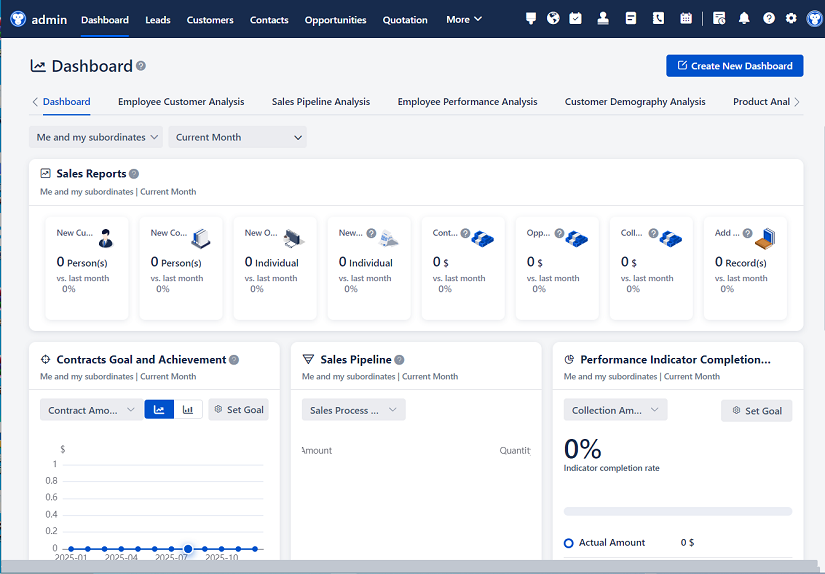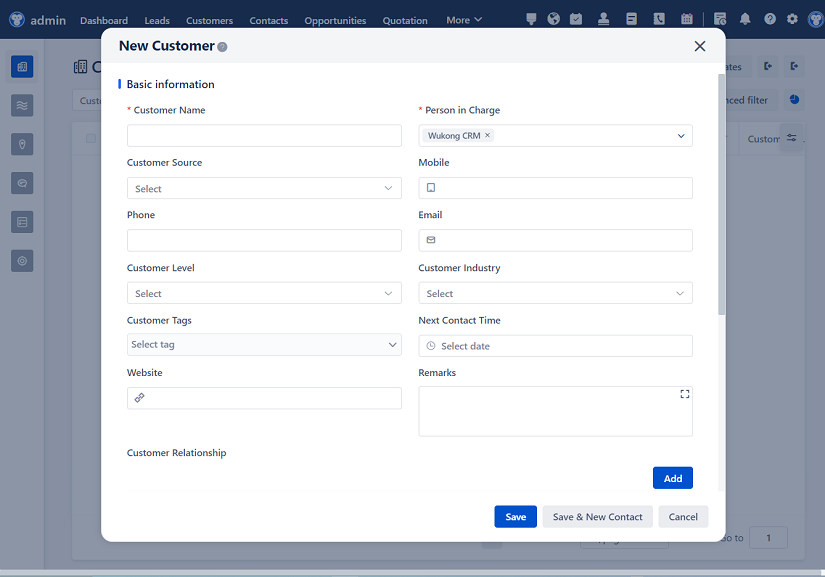
△Click on the top right corner to try Wukong CRM for free
So, let me tell you something — if you’ve ever tried to get a CRM system up and running in your company, you know it’s not just about buying software and calling it a day. I mean, sure, the sales rep made it sound like magic — “Just plug it in, and boom! All your customer data is organized!” But reality? Yeah, that’s a whole different story.
I remember when we first decided to implement a CRM at my last job. Everyone was excited — finally, no more spreadsheets floating around, no more missed follow-ups, right? Well… not exactly. We had all these high hopes, but within a few weeks, people were frustrated, data wasn’t syncing properly, and honestly, most of the team just went back to using sticky notes.
Free use of CRM system: Free CRM
That’s when I realized: implementing a CRM isn’t about the tool itself — it’s about how you use it, who uses it, and whether it actually fits into the way people work every day.
Let me break it down for you — from real experience — what actually makes a CRM implementation successful. Because trust me, it’s not just about picking the fanciest platform.
First off, leadership buy-in is absolutely critical. I can’t stress this enough. If the higher-ups aren’t actively supporting the change, then good luck getting anyone else on board. You need executives who don’t just nod along in meetings but actually use the system themselves. When the sales director starts pulling reports from the CRM during team huddles, people notice. They think, “Oh, this must be important.” That kind of visibility makes a huge difference.
And speaking of people — user adoption is probably the biggest hurdle. No matter how powerful your CRM is, if your team isn’t using it consistently, it’s basically useless. I’ve seen companies spend thousands on a top-tier CRM only to have half the staff still logging calls in notebooks. Why? Because nobody took the time to explain why it mattered or how it would make their lives easier.
So here’s a tip: involve your end users early. Don’t just roll out the system like a surprise party. Talk to your sales reps, your customer service folks, even the marketing team. Ask them what they struggle with. What information do they wish they had at their fingertips? Then show them how the CRM solves those exact problems. Make it personal. When people see value for themselves, they’re way more likely to adopt it.

Training is another thing — and I don’t mean a one-hour webinar and a PDF manual. Real training. Hands-on, role-specific, ongoing. People learn differently. Some want videos, others prefer live Q&A sessions. And let’s be honest — nobody remembers everything the first time. So offer refresher courses, quick cheat sheets, maybe even a “CRM champion” in each department who can answer questions and help troubleshoot.
Oh, and data quality? Huge. I can’t tell you how many times I’ve seen CRMs turn into digital junk drawers because nobody cleaned up the old data before importing. Duplicate entries, outdated contact info, missing fields — it all adds up. Garbage in, garbage out, right? So take the time to audit your existing data. Deduplicate, standardize formats, and set clear rules for what gets entered and how. It might feel tedious, but believe me, it pays off later.
Another thing people overlook is customization. Look, off-the-shelf CRM setups are tempting — faster, cheaper, less hassle. But if the system doesn’t match your actual business processes, you’re forcing your team to adapt to the tool instead of the other way around. That never ends well. So yes, spend some time tweaking the workflows, fields, and dashboards so they reflect how your team really works. A little customization goes a long way in making the CRM feel natural, not clunky.
Integration is another biggie. Your CRM shouldn’t live in a silo. It needs to talk to your email, calendar, marketing automation tools, maybe even your ERP system. Otherwise, you’re just creating more work — copying and pasting data between platforms. That kills efficiency and drives people nuts. So before you commit to a CRM, check what it integrates with. And test those integrations early. Nothing worse than realizing six months in that your email sync is broken.
Now, let’s talk goals. Why are you implementing a CRM in the first place? Is it to improve customer response times? Increase sales conversion rates? Get better insights into customer behavior? Whatever it is, define it clearly from the start. And then pick key performance indicators (KPIs) to measure progress. Without clear goals, you won’t know if the implementation is working — or even what “working” means.

And here’s something people forget: change management. Switching to a new CRM is a change, plain and simple. And humans? We don’t love change. So you’ve got to manage that transition carefully. Communicate openly — explain the why, the benefits, the timeline. Acknowledge the challenges. Celebrate small wins. Maybe even run a friendly competition to see who logs the most accurate data in a week. A little motivation helps.
Support matters too. Even after launch, people will have questions. Bugs will pop up. Processes will need adjusting. So make sure there’s someone — or a team — dedicated to supporting the CRM. Whether it’s internal IT, a vendor support rep, or a power user on the team, having a go-to person builds confidence and keeps things moving.
Oh, and don’t try to do everything at once. I’ve seen teams crash and burn because they wanted to migrate five years of data, customize 20 workflows, and train 100 employees all in one month. Slow and steady wins the race. Start with a pilot group — maybe one department or region — test it, fix issues, gather feedback, then expand. It reduces risk and gives you room to learn.

Security and permissions? Yeah, that’s important too. Not everyone needs access to everything. Sales managers might need full view, but a junior rep probably shouldn’t see pricing strategies or executive notes. Set up role-based permissions early so you protect sensitive data and avoid confusion.
And let’s not forget mobile access. These days, people aren’t always at their desks. Sales reps are on the road, customer service is working remotely — so your CRM needs to be accessible on phones and tablets. A clunky mobile app can kill adoption fast. Test it thoroughly. Make sure it’s intuitive and functional.
Post-launch evaluation is crucial. Don’t just flip the switch and walk away. Check in regularly — monthly, quarterly — to see how things are going. Are people using it? Is data accurate? Are you hitting your KPIs? Use feedback to make improvements. A CRM isn’t a “set it and forget it” tool. It needs ongoing care and adjustment.

One thing that helped us a lot was creating a feedback loop. We set up a simple survey every few months asking users what they liked, what frustrated them, and what they’d like to see improved. Then we shared what we learned and what changes we’d make. It showed people their input mattered — and that built trust.
Also, keep an eye on updates and new features from your CRM provider. Software evolves. New tools come out — AI-powered insights, better reporting, enhanced automation. Staying current can give you a real edge. But again, don’t just enable features blindly. Assess whether they actually add value for your team.
And finally — patience. Look, no CRM rollout is perfect. There will be glitches, resistance, moments where you wonder if it’s worth it. But if you stick with it, keep listening, keep improving, the payoff is huge. Better customer relationships, smarter decisions, smoother operations — it’s all possible.
From my experience, the companies that succeed with CRM aren’t the ones with the most expensive software. They’re the ones who treat implementation as a journey — one that involves people, process, and purpose, not just technology.
So yeah, it takes effort. But when your team actually uses the CRM, when leaders make decisions based on real data, when customers get faster, more personalized service — that’s when you know it’s working. And honestly? That feeling is pretty great.
FAQs (Frequently Asked Questions)
Q: How long does a typical CRM implementation take?
A: Honestly, it depends. Small teams might get up and running in a few weeks, but larger organizations with complex processes could take several months. The key is not rushing — better to do it right than fast.
Q: Should we hire a consultant for CRM implementation?
I’d say it depends on your internal expertise. If you’ve got tech-savvy people who understand both your business and CRM systems, maybe not. But if it’s new territory, a consultant can save you time, money, and headaches in the long run.
Q: What’s the most common reason CRM implementations fail?
In my opinion? Lack of user adoption. You can have the best system in the world, but if people don’t use it, it’s just expensive software sitting on a server.
Q: How do we get reluctant employees to use the CRM?
Start by showing them the benefit — how it saves time, reduces repetitive tasks, or helps them close more deals. Make training easy, offer support, and recognize those who embrace it. Culture matters.
Q: Can a CRM work for small businesses too?
Absolutely! In fact, smaller teams often see faster ROI because they’re more agile. Just pick a solution that fits your size and budget — no need for enterprise-level complexity.
Q: How often should we review our CRM setup?
At least twice a year. Business changes, teams grow, priorities shift. Regular check-ins help ensure your CRM still serves your needs — and hasn’t become outdated or inefficient.
Q: Is cloud-based CRM better than on-premise?
For most companies today, yes. Cloud CRMs are easier to update, scale better, and allow remote access. Plus, you don’t have to manage servers or worry about backups. But security and compliance requirements might influence your choice.
Q: What’s one thing you wish you knew before starting a CRM project?
That success isn’t measured by launch day — it’s measured by usage and results over time. Focus on the long game, not just the initial rollout.
Related links:
Free trial of CRM
Understand CRM software

△Click on the top right corner to try Wukong CRM for free